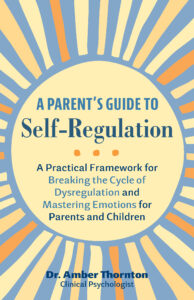
Conquering the Second Shift: Strategies for Overwhelmed Parents
- Health
Discovering the “right” way to parent a child is hard and utterly impossible. Everyone has their tactics and techniques, but the truth is the same: we all get overwhelmed. That is why Dr. Amber Thornton has curated the perfect tool for overwhelmed parents to help them navigate the ins and outs off parenting. You can find her book A Parent’s Guide to Self-Regulation: A Practical Framework for Breaking the Cycle of Dysregulation and Mastering Emotions for Parents and Children everywhere that books are sold!
***
The final work email is sent, the laptop is shut, and a sigh escapes your lips. Relief washes over you for a fleeting moment, quickly replaced by the daunting reality – the “second shift” has begun. This period, stretching from the end of the workday until bedtime, is the unsung battleground for countless parents navigating the ever-present need to juggle dinner prep, cleaning, homework battles, and precious moments of family time. It’s no wonder so many parents feel utterly overwhelmed when that second shift bell rings.
The Burden of the Second Shift
The challenges parents face during this time are multifaceted. Often, there’s a simple lack of time. Between errands, preparing a healthy meal, packing lunches for the next day, and tackling the ever-growing mountain of laundry, precious time melts away like ice on a hot stove.
Exhaustion from a long day bleeds into the evening, making it difficult to summon the patience and energy needed for quality interactions with children.
The problem is further compounded by a lack of support. In many households, the responsibility for the second shift falls primarily on one parent, creating a sense of unfairness and resentment. The constant demands and sensory overload, from the cacophony of children’s voices to the flashing lights of screens, can quickly push even the most patient parent to the brink of overstimulation.
The Toll It Takes
The impact of a chronically overwhelming second shift extends far beyond feeling a little frazzled. It can lead to an unequal division of labor within the family, creating tension and resentment between partners. The constant feeling of juggling work and personal life can disrupt work-life balance, leading to dissatisfaction in both domains. Perhaps most importantly, the stress and exhaustion can take a significant toll on a parent’s mental and emotional well-being.
Understanding Our Triggers: Overwhelm and Overstimulation
To develop effective strategies for tackling the second shift, it’s important to understand what triggers our feelings of overwhelm and overstimulation. Imagine a cup overflowing with water that’s overwhelm. Each additional task or responsibility is another drop that spills over the rim, leaving you feeling utterly swamped. Overstimulation, on the other hand, is like sensory overload. Imagine your eyes bombarded by flashing lights, your ears assaulted by loud noises, and your mind constantly buzzing with demands – that’s overstimulation. Both situations can trigger similar responses:
- Fatigue: Feeling drained and exhausted, both physically and mentally.
- Difficulty Concentrating: Finding it hard to focus on tasks or conversations.
- Irritability: Snapping at children or feeling short-tempered with family members.
- Decision-Making Difficulties: Feeling paralyzed by the sheer number of choices and decisions that need to be made.
- Isolation: Withdrawing from family interactions and social connections.
Conquering the Second Shift: Strategies and Tools
The good news is that you’re not powerless against the second shift. By employing a few key strategies and reframing your perspective on this time period, you can reclaim your evenings and turn them into opportunities for connection and family fun.
1. Setting Firm Boundaries Between Work and Family Life
The first step is to create a clear separation between your work life and your family life. This may require setting boundaries with your employer. Avoid checking work emails or taking calls outside of work hours, especially during dinner or family game nights. Utilize tools like “Do not disturb” modes on your phone and consider creating a dedicated “work zone” in your house that’s off-limits after work hours. This helps reinforce the mental shift and allows you to be fully present for your family when you’re at home.
2. Creating a Schedule and Routine
Having a structured schedule can help bring order to the chaos of the second shift. This doesn’t have to be a rigid itinerary, but rather a general framework that provides a sense of control.
Allocate specific time slots for activities like dinner, homework help, playtime, and relaxation. This helps manage expectations and provides a foundation for smooth transitions. Involve your children in creating the schedule, giving them a sense of ownership and making them more likely to cooperate.
3. The Power of Delegation and Collaboration
You don’t have to be a superhero who tackles everything alone. Delegation is your friend. Distribute age-appropriate chores amongst family members. Older children can help with setting the table, younger ones can sort laundry. Even young children can be taught to put away their toys or clear the dinner table. This not only lightens your load but also fosters a sense of responsibility and teamwork within the family. Collaboration goes beyond chores. Brainstorm ideas for dinner together, involve everyone in the cleanup process, and plan family game nights where everyone contributes to the fun.
4. Prioritizing Relaxation and Connection
Remember, the second shift isn’t just about crossing tasks off a to-do list. It’s also about connecting with your family and creating lasting memories.
- Schedule Relaxation Time: Just as you schedule time for chores and homework, schedule time for unwinding.This could be a shared family activity like reading a book together, watching a movie, or taking a walk after dinner.It could also be individual relaxation time for each family member – you might enjoy a quiet bath while your partner reads to the children or your children have designated “quiet time” with coloring books or puzzles.
- Focus on Quality over Quantity: Don’t get caught in the trap of feeling obligated to fill every hour with structured activities. Sometimes the most meaningful moments arise organically. Building a pillow fort for a family movie night, playing a spontaneous board game, or simply snuggling on the couch with your children are moments to treasure.
- Practice Mindfulness: The second shift is a prime time to practice mindfulness techniques as a family. Take a few deep breaths together after a busy day, or engage in short, guided meditations before bedtime. This helps everyone calm down, reduce stress, and become more present in the moment.
Embrace Imperfections and Let Go
Sometimes, the second shift throws unexpected curveballs. A spilled dinner, a homework meltdown, or a last-minute work call can quickly derail your carefully crafted schedule. Remember, you’re not aiming for perfection. Embrace the chaos, laugh it off together, and focus on creating a positive and supportive family environment. Let go of the guilt of not completing everything on your to-do list.
Communication is Key
Open communication with your partner is crucial. Discuss the division of chores and responsibilities. Talk about your expectations for the second shift and what you both need to feel supported. If you’re feeling overwhelmed, express your needs clearly. Your partner may be willing to adjust their schedule or lend a helping hand if they understand your struggles.
Seeking Additional Support
Don’t be afraid to seek additional support. Consider hiring a part-time housekeeper for some tasks, or explore childcare options to lighten the load on busy evenings. Talk to extended family or friends to see if they can offer help with dinners or childcare a couple of nights a week. Don’t be afraid to ask for help – it’s a sign of strength, not weakness.
Reframing the Second Shift
Instead of viewing the second shift as a chore-filled marathon, try to reframe it as an opportunity for connection. It’s a time to strengthen bonds with your children, create lasting memories, and build a foundation for a happy and healthy family. Remember, quality time spent with your children doesn’t have to be elaborate or expensive. It’s the simple, everyday moments of shared laughter, warmth, and love that truly matter.
Additional Resources
If you’re looking for further guidance on managing stress and overwhelm, consider reading my book “A Parent’s Guide to Self Regulation: A Practical Framework for Breaking the Cycles of Dysregulation and Mastering Emotions for Parents and Children.” This book provides practical strategies and techniques for managing your emotional well-being and fostering a calmer, more positive household.
This journey of conquering the second shift is an ongoing process. There will be days when you feel like a master chef and a superhero parent, and there will be evenings that leave you longing for a quiet corner to hide in. But by implementing these strategies, cultivating open communication, and prioritizing connection with your family, you can transform the second shift into a time of joy, laughter, and meaningful moments that will last a lifetime. Remember, you are not alone in this journey, and with a little planning and support, you can reclaim your evenings and build a strong, happy family unit, one second shift at a time.

Dr. Amber Thornton
Dr. Amber Thornton is a licensed Clinical Psychologist and strong advocate for the mental health and well-being of parents. Dr. Amber loves writing and creating content online that will speak to the everyday struggles of ...







